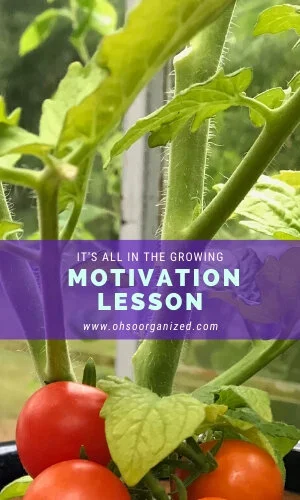When you embark on doing something new, what keeps you motivated? What helps you follow through with a project or new habits even when your goal feels big or hard to reach? I’ve said it before. The pandemic has encouraged experimentation and creativity for many of us. The uncertainty in the world created an atmosphere of trying things we’ve never done before. I’ve noticed a shift, “Life is so unpredictable, what do I have to lose?”
This brings me to a recent lesson I learned about motivation. In the spring, I planted a tiny herb and vegetable garden in our greenhouse. You can read more about it in my post, How Has Uncertainty Inspired Your Time to Be Different? After decades of convincing myself that I’m not a gardener and could not grow food, I felt motivated to try. The effect of the pandemic enabled me to try out a different script. It was a “Why not?” attitude, rather than an “I can’t” perspective.
“Motivation is in the growing.”
The Story
My motivation to create a garden came from wanting to grow my own fresh food. It turned out that selecting plants, and finding the right spot to place them was fun and straightforward. I opted for a tiny garden, which wasn’t overwhelming. Each day I cared for the plants by touching their leaves, smelling them, saying “hello,” and watering them when needed. My daily reward is that I get to pick fresh basil, dill, or cilantro to add to our salads or mint to my iced tea. The herbs have been immediately available and continue to grow.
The cherry tomato plant, however, needed time. Does that sound familiar? How often do we need more time to grow? So while I was picking my basil and dill, I cared for the tomato plant, fascinated by its growing process. Little flowers appeared. From there, tiny green tomatoes grew. Finally, one single tomato turned a luscious bright red color. I sent photos to my gardener guru friend for her advice. She confirmed that it was picking and eating time. So with great delight, I plucked the tomato, cut it in half, and shared it with my husband. It was delicious, worth the wait, and so joyful to share it with someone I love.
Big Lesson Learned
My small garden has taught me that with an open attitude, care, and patience, not only will the plants thrive, but I will also grow. Motivation is in the growing. As you take on new projects or habits, it is the journey where the magic happens. And when you arrive at your destination, I hope that your ripe red tomato will be waiting for you to appreciate and enjoy.
What motivation lessons have you noticed? What motivates you? I’d love to hear your thoughts. I invite you to join the conversation!












